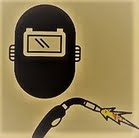Ferrite testing, also known as a ferritescope test, is a fast and non-destructive inspection technique used to measure delta ferrite levels in austenitic stainless steel and duplex stainless steel materials. Maintaining the correct ferrite content is crucial for ensuring corrosion resistance, durability, and preventing cracks in the material. Exceeding the maximum allowable ferrite content can make stainless steel welds more prone to hot cracking.
The advantages of ferrite testing include its non-intrusive nature, leaving minimal marks on the test sample. Moreover, it offers the convenience of a portable testing device that can quickly, accurately, and efficiently determine ferrite values. To perform a proper ferrite test, specific material thicknesses—both minimum and maximum—are necessary for the test specimen. The results are then interpreted based on customer-defined specifications and requirements.

✧𝗙𝗲𝗿𝗿𝗶𝘁𝗲 𝘁𝗲𝘀𝘁𝗶𝗻𝗴 is an important quality control process used to determine the ferrite content in stainless steel materials, especially welds.
→ It provides valuable information about the microstructure and predicts material behavior during fabrication and service.
✧𝗪𝗵𝗮𝘁 𝗶𝘀 𝗙𝗲𝗿𝗿𝗶𝘁𝗲?
→ Ferrite is one of the major microstructural phases found in stainless steels along with austenite.
→ It is magnetic in nature compared to non-magnetic austenite.
→ 𝑻𝒉𝒆 𝒑𝒆𝒓𝒄𝒆𝒏𝒕𝒂𝒈𝒆 𝒐𝒇 𝒇𝒆𝒓𝒓𝒊𝒕𝒆 𝒑𝒓𝒆𝒔𝒆𝒏𝒕 𝒂𝒇𝒇𝒆𝒄𝒕𝒔 𝒑𝒓𝒐𝒑𝒆𝒓𝒕𝒊𝒆𝒔 𝒍𝒊𝒌𝒆 𝒉𝒂𝒓𝒅𝒏𝒆𝒔𝒔, 𝒕𝒐𝒖𝒈𝒉𝒏𝒆𝒔𝒔, 𝒅𝒖𝒄𝒕𝒊𝒍𝒊𝒕𝒚, 𝒘𝒆𝒍𝒅𝒂𝒃𝒊𝒍𝒊𝒕𝒚 𝒂𝒏𝒅 𝒄𝒐𝒓𝒓𝒐𝒔𝒊𝒐𝒏 𝒓𝒆𝒔𝒊𝒔𝒕𝒂𝒏𝒄𝒆.
→ Ferrite improves weld strength but decreases ductility and corrosion resistance.
✧𝗧𝘆𝗽𝗲𝘀 𝗼𝗳 𝗦𝘁𝗮𝗶𝗻𝗹𝗲𝘀𝘀 𝗦𝘁𝗲𝗲𝗹𝘀:
→ 𝘼𝙪𝙨𝙩𝙚𝙣𝙞𝙩𝙞𝙘 Stainless Steels (e.g. 304, 316):
These have low ferrite content, usually < 1%. Ferrite decreases corrosion resistance.
→ 𝘿𝙪𝙥𝙡𝙚𝙭 Stainless Steels (e.g. 2205, 2507):
Contain a mix of austenite and ferrite. Require 25-65% ferrite for optimal properties.
→ 𝙁𝙚𝙧𝙧𝙞𝙩𝙞𝙘 Stainless Steels (e.g. 409, 430):
Contain up to 100% ferrite in annealed condition. Minimum 85% ferrite required.
→ 𝙈𝙖𝙧𝙩𝙚𝙣𝙨𝙞𝙩𝙞𝙘 Stainless Steels (e.g. 410, 420):
Have 75-95% ferrite in annealed state. 75-90% needed for good corrosion resistance.
✧𝗧𝗲𝘀𝘁𝗶𝗻𝗴 𝗠𝗲𝘁𝗵𝗼𝗱𝘀:
1. 𝙈𝙚𝙩𝙖𝙡𝙡𝙤𝙜𝙧𝙖𝙥𝙝𝙞𝙘 𝙏𝙚𝙨𝙩𝙞𝙣𝙜 (𝘿𝙚𝙨𝙩𝙧𝙪𝙘𝙩𝙞𝙫𝙚):
Involves microscopic analysis of etched samples. Accurate but time-consuming and requires expert analysis.
2. 𝙁𝙚𝙧𝙧𝙞𝙩𝙚𝙨𝙘𝙤𝙥𝙚 𝙏𝙚𝙨𝙩𝙞𝙣𝙜 (𝙉𝙤𝙣 𝘿𝙚𝙨𝙩𝙧𝙪𝙘𝙩𝙞𝙫𝙚):
Uses magnetic induction principle to rapidly measure ferrite content. Widely used for its speed and portability.
✧𝗙𝗲𝗿𝗿𝗶𝘁𝗲 𝗔𝗰𝗰𝗲𝗽𝘁𝗮𝗻𝗰𝗲 𝗖𝗿𝗶𝘁𝗲𝗿𝗶𝗮 𝗶𝗻 𝗪𝗲𝗹𝗱𝘀:
1.Austenitic steels: 4-8% (Keep > FN4.) ferrite prevents micro-cracking during solidification.
2.Duplex steels: 30-65% ferrite required for strength and corrosion resistance.
✧𝗖𝗼𝗻𝘃𝗲𝗿𝘀𝗶𝗼𝗻 𝗙𝗼𝗿𝗺𝘂𝗹𝗮𝘀:
→ Ferrite % = 0.7 x FN (for 22% Cr duplex)
→ Ferrite % = 0.65 x FN (for 25% Cr duplex)
→ FN = (Ferrite %) x [Formula] (for FN >10)
